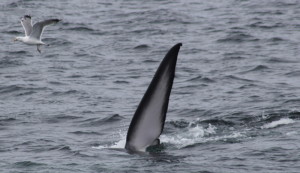Naturalist’s Notebook – May 07, 2016 to May 13, 2016
Sometimes a really important and enjoyable sighting is made by passengers even before the crew catches a glimpse of the whale. It was the passengers of the Dolphin VIII that first spotted the very fine spout of the humpback whale on May 08. Under the gray skies and during the intermittent rain, the passengers all rushed to the starboard rails. Mark Gilmore writes, “Sure enough, our one whale for the trip. Fortunately, it began breach feeding, like an open mouthed chin breach through small, fast fish.” The captain and the naturalist agree, even with the weather conditions, that the forage fish was not sand launce. The concensus is that this whale was feeding on “tinker” mackerel. Schools of it had been reported by several fishermen the day before. Mark also comments that it is interesting to note the change in behavior caused by changing species of forage fish. Usually, when humpbacks are feeding on sand eels, they have the luxury of being able to move really slow when they lunge. Sand eels can dart around rapidly but don’t move very far when they do it while surrounded by bubbles. If you have been whalewatching and witnessed a humpback whale emerging from a huge cloud of green, fizzy bubbles with its mouth wide open, a gaping maw that appears to rise from beneath the surface in slow motion, that whale was probably feeding on sand launce. But faster schooling fish like mackerel, herring, or menhaden require a bit more of an energetic approach. What you are likely to witness in that case, like they did on today’s trip, is the surface of the sea taking on a rippling aspect, like rain falling in a very localized position. It may start out slow and increase in intensity or it may just, all of a sudden, appear, a roiling plot of ocean. And then, that plot of roiling ocean will disappear, nearly in its entirety, into the open mouth of a fast lunging humpback whale, usually emerging nearly vertically from the surface of the sea. This kind of feeding is fast and exciting. And if you catch it with your camera, you feel like a king even before you see the photo.
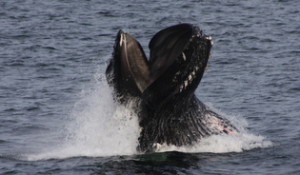
There were three kinds of baleen whales spotted on May 09, but it turned out, again, that the humpback whales were the most enjoyed by the passengers. After having a brief glimpse of a minke whale and a good look at a finback whale, the passengers and crew of the Dolphin VIII were treated to a spectacular view of two very slow moving juvenile humpbacks. It was an afternoon trip and the sun was high in the sky, illuminating the waters around the pair of whales. If their shadow against the shallow bottom hadn’t been enough to keep track of their movements when they were beneath the surface, the green reflection of their white pectoral flippers would surely have given them away. When they came to the surface each time, they would take a series of four or five breaths. They did not appear to be diving deeply between each series of breaths as one almost never lifted its flukes above the surface. The slow progress of these two animals and the shallow waters they were travelling through, allowed the passengers not just a rare look at what the proportions of a humpback whale’s body are, but, also, a very rare opportunity to witness just how graceful and majestic these giant “footballs” really are. When I was in high school, my father, who was far more of a football fan than I was, used to say, “When a good quarterback throws a pass, the flight of that football is a path of design and beauty.” Today, the passengers of the Dolphin VIII got to witness just how much the motion of a humpback whale is a path of design and beauty.
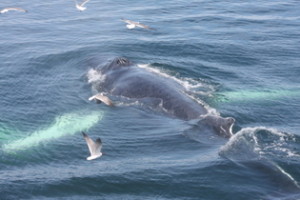
The feeding humpback whale of May 10 was employing thin streams of bubbles, bubble nets, to corral much slower forage fish into tighter balls for lunging through. Based on the description of the feeding behavior, it is ok to speculate that the animal was feeding on sand eels. Today, though, the feeding humpback whale had drawn the attention of a large mixed group of gulls. Both herring gulls and laughing gulls are scavengers when they need to be, but both species are easily attracted to the bubble nets employed by humpback whales. If you have been whalewatching, your naturalist has undoubtedly told you to be watchful for birdballs. This large group of gulls spent the better part of the afternoon hovering above the whale, watching for signs that its bubbles were pushing the fish to the surface. Of course, they do have the advantage of looking down for the bubbles instead of looking across the surface, like we have to. And their eyesight is far more acute in the blue-green spectrum than ours. You might almost think they were designed to take advantage of the whale’s efforts.
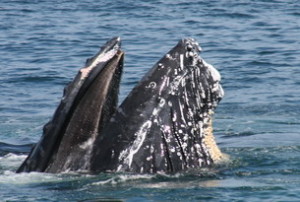
What could possibly have happened on May 11 that would prevent this naturalist from writing about the feeding behaviors of the several feeding humpback whales spotted today? I am glad you asked. Imagine that while you and your boatload of passengers are watching one of these humpbacks, you see splashing in the distance. Big splashes. Bigger splashes than would be caused by a feeding humpback whale. You hesitate. You have gone to investigate splashes before, just to get there when the splashing ends. But the splashes continue. Big splashes. The humpback whale goes down again. Now your passengers are noticing the distant splashes. They are pointing. Even from this distance, you can see the dark form of the whale’s tail stalk and flukes rising above the surface and being brought down with force on the gentle swell of the surface. You look at the mate. You look at the naturalist. You look again at the pointing passengers. You commit yourself. As soon as the humpback is clear of the vessel, you engage the throttle and begin to make your way toward the source of the whitewater.
As you get closer to the animal, you notice a few things. First, the whale is definately lobtailling. You and your passengers are mesmerized by the light of the sun glistening off the wet body of the whale as it lifts its tail toward the sun and brings it crashing down in a storm of splash and white that change both the color and texture of the gently rolling sea. Next you notice that the the trailling edge of the whale’s flukes is smooth. And the flukes kind up cup up as your eyes make their way toward the tips. The body is jet black. And there is no dorsal fin. THERE IS NO DORSAL FIN.
You pull back on the throttles. You are still a third of a mile away and the passengers are still pointing but you pull back on the throttles. There is no dorsal fin. In a way you are a little disappointed because you already know that you are not going to get any closer to this whale. It is a Right Whale. And because of their critically endangered statis, there are federal laws in place to protect right whales from the actions of men. One of them simply says that you cannot move your vessel to within 500 yards of a right whale. You understand why it’s necessary to keep your distance, and not just from the legal standpoint, but still, you are witnessing something that few passengers ever get to.
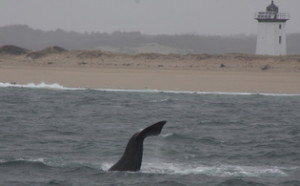
And then you remember that, even today, there are biologists that have spent a lifetime studying North Atlantic Right Whales and have never seen one. And they, just like your passengers and most of your crew, have never seen one lobtailling like this.
By now, your naturalist has explained to the passengers what the animal is and why you can’t get any closer. That doesn’t stop them from watching. Why should it, it doesn’t stop you. And on the way back to the harbor, your naturalist tells you that one of the school students from Brewster on the trip said, “it didn’t act endangered.”
In the event you don’t quite see it, this sighting was far bigger than the minke whale and the several finback whales and the close to a dozen feeding humpback whales. The rarity of the animal and the rarity of the behavior mark this as a more than splendid adventure.
Somebody decided that 8:30 in the morning on May 12 would be a good time to charter the whalewatch boat. As it turns out, they were right. It begins as a beautiful day. The sea is flat and glassy calm. And for some reason the captain decides to go east of Stellwagen Bank. It’s a long ride. Until you get past the Race Point ranger station, you are still bound by the right whale 10 knot speed limit. Once you get there, you still have around eight or more miles to go. But when the Dolphin VIII and its passengers got there, they were rewarded by a sighting of three mature humpback whales. They had seen a couple of whales on the way there, but these three took up a bit of interest in the boat. They were curious. It should be pointed out that they were not curious about the people in the boat but about the boat itself. About the sounds made by the boat. About the shade the boat created. About its shape beneath the surface. And, maybe, about the way it reflected the sunlight onto the surface. Witnessing the curiousity of mammals, whether they are dogs or raccoons or whales, is really fun. In many ways it serves to remind us of the built in curiousity we had in our youth. As I get older, and in just two weeks, I will officially be old (not just older), I am amazed to find the things that make me remember my youth and that cause me to relive it. Despite my advancing years, the two decades of whalewatching has kept me young.
And about May 12, Dennis Minsky reports, “Unbelievable trip: 4 species of cetaceans! Large pod of lags [atlantic white-sided dolphins] accompanying feeding [humpback] and [finback]: 4 [finbacks] side by side, [a sighting I] have not seen in some time.”
Liz Bradfield describes the morning trip of May 13 as, “amazing/” She says that the side-lunging finback whale could be seen swimming on its side with the tip of one fluke above the surface of the water. Finback whales have a thin layer of blubber compared to humpacks and right whales. Their bodies are denser than the water around them so they do not usually lift their flukes above the surface to dive. It is incredibly rare to see the underside of the finback’s tail. This finback whale was rolling on its side as it lunged through the school of fish close enough to the surface that the underside of its tail could be viewed by the passengers!
